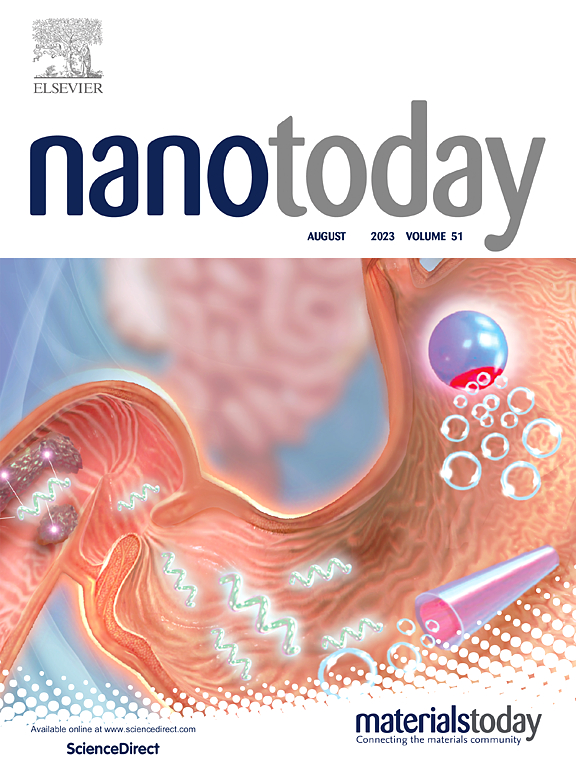纳米酶负载纳米纤维敷料增强树突状细胞的胞浆功能,促进糖尿病伤口愈合
IF 10.9
1区 材料科学
Q1 CHEMISTRY, MULTIDISCIPLINARY
引用次数: 0
摘要
通过抑制膜转运蛋白SLC7A11改善树突状细胞(DCs)的胞吐作用已被探索用于治疗糖尿病伤口。然而,SLC7A11抑制剂的使用与活性氧(ROS)的产生有关,这可能会损害DCs的生存能力和功能。为了减轻这种不利影响,开发了一种负载纳米酶的纳米纤维敷料,称为GIPH。这种敷料在核心层中封装了一种特定的SLC7A11抑制剂(HG106),并在外壳层中加入了一种高效的纳米酶Ir NPs-PVP。Ir NPs-PVP纳米酶能有效中和HG106产生的ROS,从而提高DCs的生存能力,进一步促进其efferocytic。我们的体外实验结果表明,与单独使用HG106处理的骨髓来源树突状细胞相比,giph处理的骨髓来源树突状细胞(bmdc)的存活率提高了1.68倍,efferocysis率提高了1.52倍。此外,在糖尿病小鼠伤口模型中,GIPH组显示出更好的愈合结果,伤口在第12天几乎完全恢复(97.5% %)。这项研究强调了纳米酶负载纳米纤维敷料的治疗潜力,同时为未来研究dcs介导的伤口愈合过程提供了有价值的见解。本文章由计算机程序翻译,如有差异,请以英文原文为准。
Enhance efferocytosis capacity of dendritic cells for diabetic wound healing by nanozyme-loaded nanofiber dressings
Improving efferocytosis of dendritic cells (DCs) by inhibiting membrane transporter protein SLC7A11 has been explored for healing diabetes wounds. However, the administration of SLC7A11 inhibitors has been linked to the generation of reactive oxygen species (ROS), which may compromise the viability and functionality of DCs. To mitigate this adverse effect, a nanozyme-loaded nanofiber dressing, termed GIPH, was developed. This dressing encapsulates a specific SLC7A11 inhibitor (HG106) in the core layer and incorporates an efficient nanozyme, Ir NPs-PVP, in the shell layer. The Ir NPs-PVP nanozyme effectively neutralizes ROS produced by HG106, thereby enhancing the viability of DCs and further promoting their efferocytosis. Our in vitro experiment results demonstrated that GIPH-treated Bone Marrow-Derived Dendritic Cells (BMDCs) exhibited a 1.68-fold increase in survival and a 1.52-fold enhancement in efferocytosis rate compared to those treated with HG106 alone. Furthermore, in a diabetic mouse wound model, the GIPH group showed superior healing outcomes, with wound nearly achieving complete recovery by day 12 (97.5 %). This research highlights the therapeutic potential of nanozyme-loaded nanofiber dressings while providing valuable insights for future investigations into the DCs-mediated wound healing process.
求助全文
通过发布文献求助,成功后即可免费获取论文全文。
去求助
来源期刊

Nano Today
工程技术-材料科学:综合
CiteScore
21.50
自引率
3.40%
发文量
305
审稿时长
40 days
期刊介绍:
Nano Today is a journal dedicated to publishing influential and innovative work in the field of nanoscience and technology. It covers a wide range of subject areas including biomaterials, materials chemistry, materials science, chemistry, bioengineering, biochemistry, genetics and molecular biology, engineering, and nanotechnology. The journal considers articles that inform readers about the latest research, breakthroughs, and topical issues in these fields. It provides comprehensive coverage through a mixture of peer-reviewed articles, research news, and information on key developments. Nano Today is abstracted and indexed in Science Citation Index, Ei Compendex, Embase, Scopus, and INSPEC.
 求助内容:
求助内容: 应助结果提醒方式:
应助结果提醒方式:


